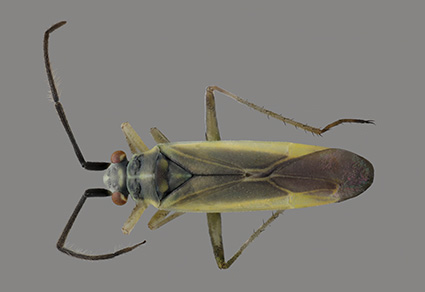Abstract
The life cycle of the phyline plant bug Conostethus americanus Knight 1939 (Hemiptera: Heteroptera: Miridae: Phylinae) is described from native mixed-grass prairie in southeast Wyoming. The bug is monophagous, univoltine, and overwinters as eggs in tufts of its host, Sandberg bluegrass (Poa secunda J. Presl, Poaceae). Eggs are laid in the host’s leaf sheaths and occasionally along the rib of wilted leaves. The eggs hatch in April, coinciding with the host’s first spring leaf growth. During the daytime, older nymphs (instars III–V) and recently molted adults are typically found on bare ground, adjacent to the host tuft crowns. After dark, the nymphs and recently molted adults climb onto the leaves to feed. The first adults appear in early May. Males outnumber females 1.5:1. Mating and oviposition occur during the latter half of May and early June. The distribution of C. americanus and its host are mapped. Seasonality is described. Host specificity and habitat affinity, which prevent competition with the ubiquitous Labops hesperius (Hemiptera: Heteroptera: Miridae), are discussed. Photographs of adults, eggs, nymphs, host feeding damage, and habitat are provided.
References
- GBIF. 2023. GBIF Occurrence Download; https://doi.org/10.15468/dl.tnvd2g [last accessed 1 June 2023].
- Halvorson, R. 2011. Sandberg bluegrass (Poa secunda). Kalmiopsis 28: 10–15. https://www.npsoregon.org/kalmiopsis/kalmiopsis18/2halvorson.pdf.
- Howard, J. L. 1997. Poa secunda. In Fire Effects Information System; https://www.fs.usda.gov/database/feis/plants/graminoid/poasec/all.html [last accessed 9 June 2023].
- Kellogg, E. A. 1985. Variation and names in the Poa secunda complex. Journal of Range Management 38: 516–521. https://doi.org/10.2307/3899743.
- Kelton, L. A. 1980. The plant bugs of the prairie provinces of Canada. Heteroptera: Miridae. The insects and arachnids of Canada. Part 8. Agriculture Canada Research Publication No. 1703, Ottawa. 408 pp. https://publications.gc.ca/site/eng/9.811275/publication.html.
- Knight, D. H., G. P. Jones, W. A. Reiners, and W. H. Romme. 2014. Mountain and Plains: the Ecology of Wyoming Landscapes. Second edition. Yale University Press, New Haven and Biodiversity Institute, University of Wyoming, Laramie. 404 pp. https://doi.org/10.2307/3673707.
- Knight, H. H. 1939. Conostethus americanus new species from Colorado, Montana and South Dakota (Hemiptera, Miridae). Entomological News 50: 132–133. https://www.biodiversitylibrary.org/item/20181#page/172/mode/1up.
- Knowlton, G. F. 1954. Some Utah insects of 1954. Part 1. Utah State Agricultural College Mimeograph Series 133: 1–18.
- Kondratieff, B. C. and J. P. Schmidt. 2005. Insect surveys of Lander and Lovel Local Training Areas, 2004-2005, Wyoming Army National Guard. Center for Environmental Management of Military Lands, Colorado State University, Ft. Collins. TPS 05-014. 121 pp.
- Mills, H. B. 1939. Montana insect pests for 1937 and 1938. Montana Agricultural Experiment Station Bulletin 366. 32 pp. https://www.biodiversitylibrary.org/item/66506#page/3/mode/1up.
- Mills, H. B. 1941. Montana insect pests for 1939 and 1940. Montana Agricultural Experiment Station Bulletin 384. 28 pp. https://www.biodiversitylibrary.org/item/73843#page/3/mode/1up.
- Polhemus, D. A. 1994. An annotated checklist of the plant bugs of Colorado (Heteroptera: Miridae). Pan-Pacific Entomologist 70: 122–147. https://www.jstor.org/stable/25010515.
- Rocky Mountain Herbarium. 2023. Rocky Mountain Herbarium Specimen Database; http://rmh.uwyo.edu/data/search.php [last accessed 15 May 2023].
- Rogler, G. A. and R. J. Lorenz. 1983. Crested wheatgrass – early history in the United States. Journal of Range Management 36: 91–93. https://doi.org/10.2307/3897991.
- SCAN. 2023. SCAN Occurrence Download; https://scan-bugs.org/portal/collections/list.php?taxa=Conostethus%20americanus&thes=1&type=1&db=all&page=1 [last accessed 6 June 2023].
- Scudder, G. G. E. 2008. New provincial and state records for Heteroptera (Hemiptera) in Canada and the United States. Journal of the Entomological Society of British Columbia 105: 3–18. https://journal.entsocbc.ca/index.php/journal/article/view/34.
- Schuh, R. T. 2002–2013. Systematic Catalog of Plant Bugs (Insecta: Heteroptera: Miridae); http://research.amnh.org/pbi/catalog/ [last accessed 9 May 2023].
- Schuh, R. T. and K. L. Menard. 2013. A revised classification of the Phylinae (Insecta: Heteroptera: Miridae): arguments for placement of the genera. American Museum Novitates No. 3785. 72 pp. https://doi.org/10.1206/3785.2.
- Skinner, Q. D. 2010. A Field Guide to Wyoming Grasses. Education Resources Publishing, Cummings, Georgia. 596 pp.
- Soreng, R. J. and L. J. Gillespie. 2018. Poa secunda J. Presl (Poaceae): a modern summary of infraspecific taxonomy, chromosome numbers, related species and infrageneric placement based on DNA. PhytoKeys 110: 101–121. https://doi.org/10.3897/phytokeys.110.27750.
- Spangler, S. M. and J. A. MacMahon. 1990. Arthropod fauna of monocultures and polycultures in reseeded rangelands. Environmental Entomology 19: 244–250. https://doi.org/10.1093/ee/19.2.244.
- Stehlik, J. L. 1977. New records of Heteroptera from Moravia. Acta Musei Moraviae 62: 169–170. https://research.amnh.org/pbi/catalog/references.php?id=354
- Todd, J. G. and J. A. Kamm. 1974. Biology and impact of a grass bug Labops hesperius Uhler in Oregon rangelands. Journal of Range Management 27: 453–458. https://doi.org/10.2307/3896721.
- U.S. Department of Agriculture. 1962. Cooperative Economic Insect Report. Agricultural Research Administration, Bureau of Entomology and Plant Quarantine 12, No. 1. 749 pp. https://www.biodiversitylibrary.org/item/99859#page/7/mode/1up.
- U.S. Department of Agriculture. 2009. Sandberg Bluegrass Plant Guide. IDPMC 8314; https://nrcs.usda.gov/plantmaterials/idpmspg8314.pdf [last accessed 10 June 2023].
- Vaness, B. M. and S. D. Wilson. 2007. Impact and management of crested wheatgrass (Agropyron cristatum) in the northern Great Plains. Canadian Journal of Plant Science 87: 1023–1028. https://doi.org/10.4141/cjps07120.
- Wheeler, A. G., Jr. 2001. Biology of the Plant Bugs (Hemiptera: Miridae) Pests, Predators, Opportunists. Cornell University Press, Ithaca and London. 507 pp. https://doi.org/10.5860/choice.39-3385.
- Woodroffe, G. E. 1959. Notes on some Hemiptera-Heteroptera from Witley Common, Surrey. Entomologist 92: 6–13. https://research.amnh.org/pbi/catalog/references.php?id=354
- Wyoming Water Resources Data System/State Climate Office. 2023. Percentage of Platte County, Wyoming in each Drought Category by Week; http://www.wrds.uwyo.edu/drought/ timelines/PlatteCoDroughtTimeline.html [last accessed 19 May 2023].


